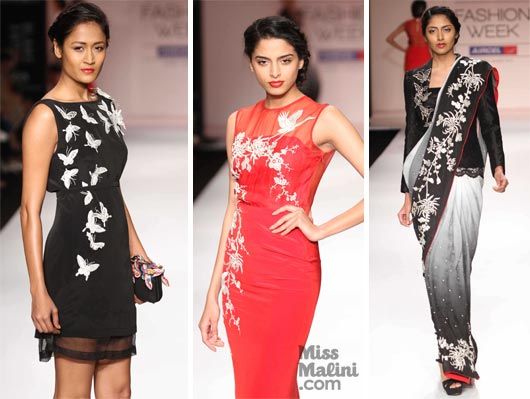

Day four of Lakme Fashion Week was Indian Textile Day—a day which I always look forward to. It’s a celebration of weaves and crafts. These are what make Indian fashion unique/ The day started with a workshop moderated by Parmesh Shahani, and on the panel were Ritu Kumar, the doyenne of design in India, Sangita Katiwada, a well known promoter of crafts and Westside’s Gaurav Mahajan. It was Ritu who set the tone of the day when she commented how India has managed to escape being colonized by Europe in its fashion thanks to the confidence that we have in our own crafts.

First up was a show curated by Delhi based textile designer Mayank Singh Kaul—he choose three designers who all who a very different take on the Indian sensibility. Ashdeen Lilowala is well known for his use of Parsi gara, a very distinctive bold thread embroidery. Ashdeen gave Parsi gara a modern take with his LBDs and evening dresses. These were everyday silhouettes with a point of difference. Nothing (even the saris) was over embellished and this dramatic form of Indian embroidery was used with restraint— a lesson other designers could learn from.

Next up was Akaaro (Delhi’s Gaurav Jai Gupta is behind this label). Known for his weaves, he has been asked to develop a fabric by Jimmy Choo himself. He showed his élan for textile by making saris that had pallaus using a different weave, yet it was woven as one continual fabric. Innovation is key to any craft and this is what makes Gaurav’s work stand-out.

Ashdeen and Gaurav’s work is something most of us in fashion have been exposed to; so the real find was Swati Kalsi. She had put together a catwalk collection for the first time. Giving Indian tussar silks a new feel, and all her work was handcrafted. Her work is also on display in London’s Victoria and Albert Museum—and it is no wonder Lakmé Fashion Week awarded her the Heritage Award.



Now after a encouraging first show the next few disappointed. I have to admit after watching a show or two I decided to move to the Tigre Blanc so I could enjoy a “Naked” Martini while seeing some shows on the monitor which really are not worth mentioning. Soumitra Mondal’s collection does deserve a special mention. Jamdani, and khadi and his very Indian colour palette of “rani” pink and white gave his designs a delicate yet striking feel. His saris had me wishing there was a festival to be around the corner to give me an excuse to dress traditional.

Many designers who had already shown at Lakmé Fashion Week used textile and craft so well that it was shame that designers who were given shows on “Textile Day” did not live up to expectations. Krishna Mehta the day before had given tie and dye, shibori and block printing a modern context. On Saturday Nupur Kanoi‘s “Ladies and Gentlemen” collection took to the ramp. She “sexed” up traditional male silhouettes such as the pathani and lunghi. Her confident used of zari added freshness. The added bonus was that all her fabrics were organic. And I hope to see both these designers show on Textile Day next season.
Vinay Pathak also joined the models in displaying a creation by Agnimitra Paul on textile day during Lakmé Fashion Week in Mumbai.
And Belly Dancer Colleena Shakti opened the show for Rohit & Abhishek.

Textile Day ended with a show by Vikram Phadnis. He had nearly 40 celebrities take to the ramp (including Malaika, Arbaaz and their son Arhaan who made his catwalk debut). It was an all khadi collection—and let’s hope the celebrity quotient brings attention to Indian Textiles. After all international fashion house like Hermès, Oscar de la Renta and Lanvin come to India to source textiles and crafts so it is something we should be showing off proudly.

